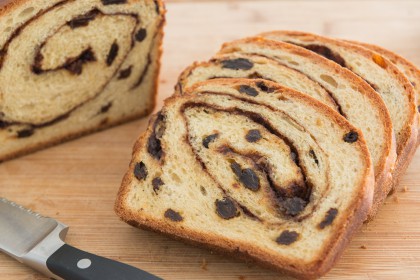Homemade Cinnamon Raisin Bread
Homemade Cinnamon Raisin Bread

Cinnamon Raisin was my toast of choice when I was a kid, and it still is today. I love that swirl of sweet cinnamon and brown sugar all throughout each slice, and the juicy raisins dotted into the dough.
I’ve experimented with all sorts of homemade breads over the years, but truthfully, after making everything from homemade baguettes to ciabatta to paesano, I usually leave the fancier breads to the bakery and stick to making simpler things like sandwich bread at home.

There are a few reasons I like making my own cinnamon raisin bread at home.
- First, a lot of sandwich breads at the store have a lot of preservatives and additives, and generally speaking, I prefer not to eat those.
- Second, I get to load the bread up with as many raisins as I’d like, and I also get to use my fancy cinnamon (not all cinnamon is created equal).
- And third, it’s fun and easy to make. Really. There’s something so satisfying about making your own bread, and it makes your house smell dreamy.

The recipe I’m sharing today is adaptable to suit different dietary needs, so it can be enjoyed by many. It can be made with dairy (mmm, butter), or it can be made without it. I’ll share different substitutions you can use throughout the recipe.

To get started, mix together warm milk, yeast, and brown sugar, and let it sit for 10 minutes until it foams up. That indicates that the yeast is ready and awake!
As far as the milk goes, you can use cow’s milk, almond milk, soy milk, rice milk … pretty much any flavorful milk liquid here.

Next, in the bowl of a stand mixer, add the yeast milk mixture, two eggs, and some melted butter or oil. For oils, you can do grapeseed oil, canola oil, vegetable oil, light olive oil, and so on.

Whisk that together to combine, then add all-purpose flour and salt.

Use the dough hook or a spoon to roughly combine the dough.

Then fit the bowl and hook onto the stand mixer, add ½ cup of raisins, and knead for 10 minutes on medium low speed.

Remove the dough hook. Full disclosure: the dough will be sticky!

Cover the bowl with a towel or plastic wrap, and let the dough rise for one hour, until doubled.

In a small bowl, combine brown sugar, ground cinnamon, and either melted butter or oil. This will be the cinnamon swirl filling.

Dust a flat surface very lightly with flour, then stretch the dough out into a rectangle, approximately 9 inches long and 18 inches wide. It doesn’t have to be exact, but you want to imagine rolling it up the long way and having it fit neatly into a 9×5 loaf pan.

Sprinkle the cinnamon sugar filling onto the bread, then roll it up, as tightly as you can.

Place the roll seam-side down into a greased 9×5 loaf pan, then cover with plastic wrap. Let it rise for another 30 minutes.

Bake the bread for about 45 minutes, until the interior registers at 190ºF to 200ºF with a thermometer, and the crust is golden brown.

Let the bread cool completely before slicing, then enjoy!

Homemade Cinnamon Raisin Bread
INGREDIENTS
FOR THE DOUGH:
- 1 cup Milk, Almond Milk, Or Soy Milk, At 110ºF
- 2 Tablespoons Brown Sugar (See Note)
- 2-1/4 teaspoons Instant Rise Yeast
- 6 Tablespoons Neutral Oil (See Note) Or Melted Unsalted Butter
- 2 Eggs
- 3-1/2 cups All-purpose Flour (17 1/2 Ounces By Weight), Plus More For Dusting
- 1 teaspoon Salt
- 1/2 cup Raisins
FOR THE CINNAMON FILLING:
- 1/3 cup Brown Sugar
- 2 Tablespoons Ground Cinnamon
- 3 Tablespoons Melted Butter (or Oil)
INSTRUCTIONS
- Combine milk, brown sugar, and yeast in a bowl or measuring cup. Let sit for 10 minutes, until foamy. This indicates that the yeast is alive and well.
- Pour the yeast liquid into the bowl of a stand mixer, and add oil and eggs. Whisk to combine the wet ingredients, then add flour and salt. Use the dough hook or a spatula to roughly combine the wet and dry ingredients into a shaggy dough. Add the raisins, then fit the bowl and dough hook to the stand mixer. Knead on medium low speed for 10 minutes.
- Remove the dough hook, cover the bowl with plastic wrap, and let the dough rise for 1 hour, until doubled in size.
- Flour your countertop as lightly as possible, then spread and stretch the dough into a rectangle that is the length of your loaf pan, about 9 inches by 18 inches. I prefer to use a 9x5 loaf pan.
- Make the cinnamon filling by stirring together brown sugar, cinnamon, and butter. Spread this mixture all over the top of the dough rectangle, then roll the dough up as tightly as you can, rolling the long way. Place the roll seam-side down into a greased loaf pan, then cover with plastic wrap to let rise for 30 minutes.
- Preheat oven to 375ºF, then bake bread for 40–50 minutes until the inside reads 190ºF to 200ºF with a thermometer. Let the bread cool completely on a wire rack before slicing. Enjoy!
Notes:
1. The 2 tablespoons brown sugar won’t make the bread very sweet. If you want a sweeter loaf, double the brown sugar.
2. I use grapeseed oil, but you could also use canola oil, vegetable oil, a light olive oil, etc.
3. The dough will be sticky, but resist the urge to add more flour, as it will make the bread more dense.
Storage: Since there are no preservatives, the bread will only keep for a few days at room temperature. I recommend freezing any unused bread.
more recipes @ https://thepioneerwoman.com
BERITA LENGKAP DI HALAMAN BERIKUTNYA
Halaman Berikutnya